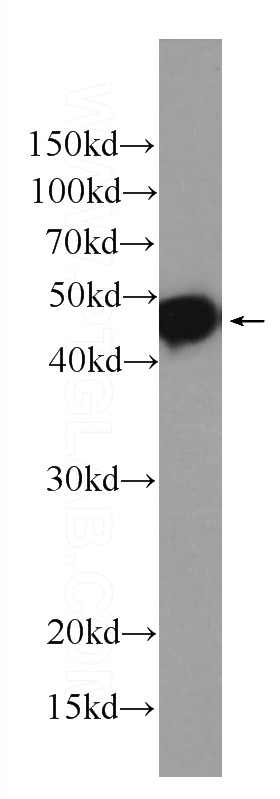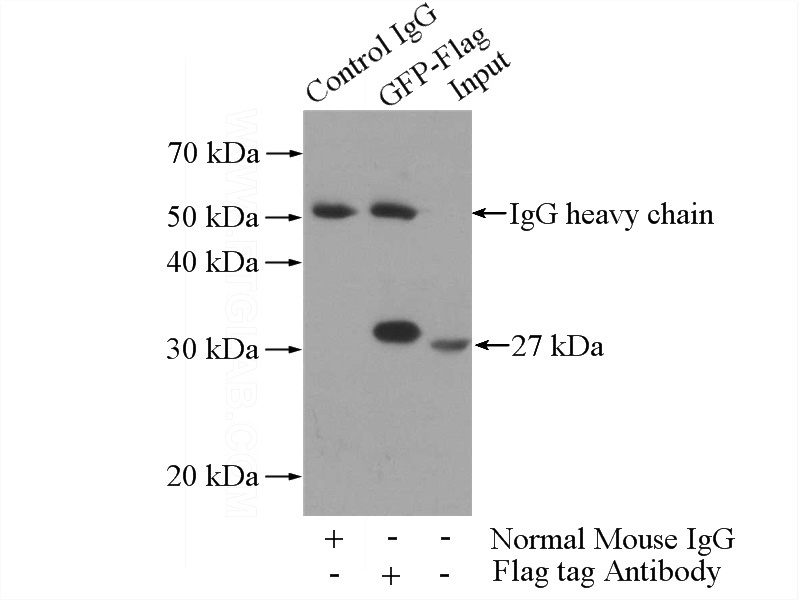-
Product Name
Flag tag antibody
- Documents
-
Description
Flag tag Mouse Monoclonal antibody. Positive IP detected in Recombinant protein protein. Positive WB detected in Recombinant Protein.
-
Tested applications
ELISA, WB, IP
-
Species reactivity
Tag
-
Alternative names
DYKDDDDK antibody; Flag antibody; Flag M2 antibody; Flag Tag antibody; FlagM2 antibody
-
Isotype
Mouse IgG2b
-
Preparation
This antibody was obtained by immunization of Peptide. Purification method: .
-
Clonality
Monoclonal
-
Formulation
PBS with 0.02% sodium azide and 50% glycerol pH 7.3.
-
Storage instructions
Store at -20℃. DO NOT ALIQUOT
-
Applications
Recommended Dilution:
WB: 1:2000-1:20000
IP: 1:1000-1:10000
-
Validations

WB result of anti-Flag (Catalog No:117314, 1:8000) with Flag-recombinant protein.

IP Result of anti-Flag tag (IP:Catalog No:117314, 3ug; Detection:Catalog No:117313 1:2000) with Recombinant protein protein lysate 1280ug.
-
Background
Protein tags are protein or peptide sequences located either on the C- or N- terminal of the target protein, which facilitates one or several of the following characteristics: solubility, detection, purification, localization and expression. The DYKDDDDK(FLAG) peptide has been used extensively as a general tag in expression vectors. This peptide can be expressed and detected with the protein of interest as an amino-terminal or carboxy-terminal fusion. N-terminal FLAG vectors provide an Ek cleavage site for removal of the fusion tag. The FLAG peptide is likely to be located on the surface of a fusion protein because of its hydrophilic nature. As a result, the FLAG peptide is more likely to be accessible to antibodies. A FLAG-tag can be used in many different assays that require recognition by an antibody, such as western blotting, immunocytochemistry, immunoprecipitation, flow cytometry, protein purification, and in the study of protein-protein interactions, cell ultrastructure, and protein localization and so on. This antibody is a mouse monoclonal antibody raised against 3xFlag (3xDYKDDDDKT) sequence and recognizes the (3x)DYKDDDDK peptide and detects FLAG-tagged proteins.
-
References
- Zhou X, Kong X, Xu W, Chen J. Overexpression of APRIN inhibits differentiation and proliferation and promotes apoptosis in P19 embryonal carcinoma cells. Molecular biology reports. 40(1):491-5. 2013.
- Yunlei Z, Zhe C, Yan L. INMAP, a novel truncated version of POLR3B, represses AP-1 and p53 transcriptional activity. Molecular and cellular biochemistry. 374(1-2):81-9. 2013.
- Xiang R, Zhao S. RTN3 inducing apoptosis is modulated by an adhesion protein CRELD1. Molecular and cellular biochemistry. 331(1-2):225-30. 2009.
- Xu H, Yao L, Lu S, Qi Y. Host filamentous actin is associated with Heliothis armigera single nucleopolyhedrosis virus (HaSNPV) nucleocapsid transport to the host nucleus. Current microbiology. 54(3):199-206. 2007.
- Xiang R, Liu Y, Zhu L, Dong W, Qi Y. Adaptor FADD is recruited by RTN3/HAP in ER-bound signaling complexes. Apoptosis : an international journal on programmed cell death. 11(11):1923-32. 2006.
Related Products / Services
Please note: All products are "FOR RESEARCH USE ONLY AND ARE NOT INTENDED FOR DIAGNOSTIC OR THERAPEUTIC USE"
